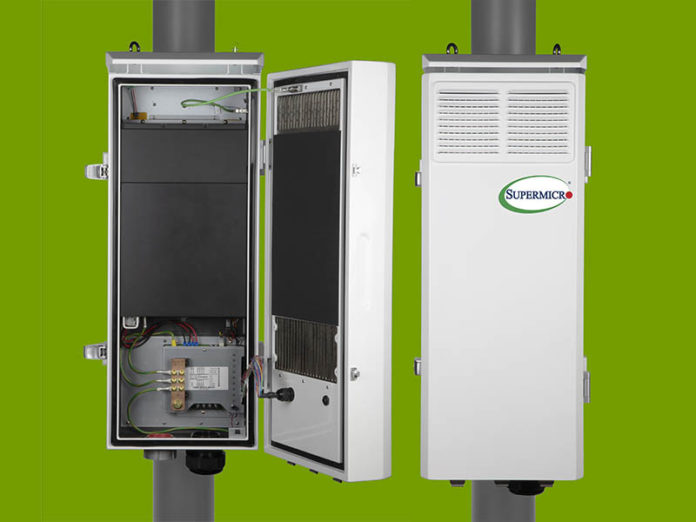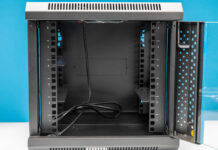By most accounts, the 5G edge buildout will be an enormous global infrastructure upgrade that will increase processing needs at the edge. Much of that processing will be done in servers deployed in places outside of corporate or cloud datacenters. As a result, companies like Supermicro are releasing designs to address these emerging needs. An example is today’s Supermicro IP65 edge server for telco poles.
Supermicro IP65 Edge Servers for 5G Telco Poles
The new Supermicro IP65 edge servers that it is calling part of its Outdoor Edge Systems line, is designed to be deployed atop a telco pole. You can see this in the photo above. That is important in the industry as the telecom provider may have rights to the pole, but not necessarily rights to the property beneath and around that pole. As a result, the footprint absolutely matters for those looking at 5G RAN/ O-RAN solutions.
Housing the 5G edge servers is an IP65 enclosure designed to withstand environments around the pole. The servers themselves are designed to utilize Intel Xeon D processors as well as 2nd Gen Intel Xeon Scalable processors including the new 2nd Gen Intel Xeon Scalable Refresh SKUs. While Supermicro has sold Xeon D and Xeon Scalable servers for years, it is the packaging design that is new here.
The new edge servers can utilize up to three PCIe Gen3 to add accelerators such as FPGAs and GPUs. Supermicro is highlighting Intel FPGAs and NVIDIA GPUs such as the NVIDIA Tesla T4. For storage, these new systems have a traditional 2.5″ SSD form factor as well as M.2 and EDSFF SSD form factor capabilities. Supermicro highlights these capabilities and potential use cases such as storing local video content. With accelerators this can be a platform to perform analytics on video feeds to filter what should be sent to the cloud for further analytics.
Final Words
There is going to be a considerable investment both from systems providers as well as silicon providers over the next few years to address the 5G infrastructure build-out. Next, we hope to see Supermicro adopt the Intel Atom P5900 Series in their edge solutions as Intel and others roll-out their new product lines to meet the demands of explosive endpoint bandwidth growth.





What’s the temperature range of these things? I assume they just blow ambient air over the components and forgo air conditioning so wouldn’t they have restrictions on climates they can be safely deployed in? Are there strict component requirements for the same (e.g. some GPUs are OK but others can’t handle the temperature range)?
@Jon – I have seen equipment of this nature (industrial computers and switches) mounted in cabinets on telephone poles and in road-side utility cabinets in Calgary and Edmonton. The temperature in these cities ranges from -40C to +30C ambient every year. With the sun hitting the cabinets in the summer the temperature inside would be higher still.
now this is neat
this is cool, but i wonder how they deal with humidity and rain (moisture). very interesting.
From their specs:
Operating temp: -40°C to +50°C (depending on configuration)
300W Heater and High-Efficiency Heat Exchanger
Please review this!
There’s an air-to-air heat exchanger at the cabinet door, so internal (hot) air is circulated and heat transferred through the heat exchanger to outside air (cool). Both air circuits do not mix, hence the IP65 rating. In colder climates and seasons the heater serves to prevent condensation inside the enclosure.
This kind of stuff are quite expensive but relatively maintenance free. It’s quite common in telecom and industrial environment (vendors such as Rittal and Hoffman do manufacture them).